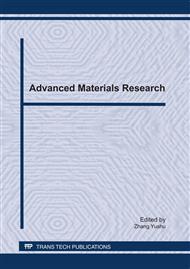[1]
L. Pelusi, A. Passarella, M. Conti, Opportunistic networking: data forwarding in disconnected mobile ad hoc network, IEEE Communications Magazine, vol. 44 no . 11, pp.134-141, (2006).
DOI: 10.1109/mcom.2006.248176
Google Scholar
[2]
Juang P, Oki H, Martonosi M, et al. Energy-efficient computing for wildlife tracking: design tradeoffs and early experiences with zebranet [C]/ASPLOS'02. San Jose: ACM, 2002: 96–107.
DOI: 10.1145/605432.605408
Google Scholar
[3]
The Project of ZebranNet Wildlife Tracker. http: /www. ee. princeton. edu/~mrm/zebranet. html.
Google Scholar
[4]
Doria A, Udn M, Pandey D P. Providing connectivity to the saami nomadic community [C]/the 2nd International Conference on Open Collaborative Design for Sustainable Innovation (dyd 02). Bangalore: Think Cycle Press, (2002).
Google Scholar
[5]
Disruption tolerant networking [EB/OL]. http: /www. darpa. mil/ato/solicit/DTN/, (2008).
Google Scholar
[6]
Vahdat A, Becker D. Epidemic routing for partially connected ad hoc networks[R]. Duke University, (2000).
Google Scholar
[7]
GAO Yue, TANG Bi-hua , Double-Backup Multipath Routing for Mobile Ad Hoc Networks,Journal of Beijing University of Posts and Telecommunications,vol. 31, no. 1, 2008. 30-34.
Google Scholar
[8]
T . S mall and Z .J. Haas, The Shared Wireless Infostation Model-A New Ad Hoc Networking Paradigm, Mobihoc 2003, June 1-3, (2003).
DOI: 10.1145/778415.778443
Google Scholar
[9]
F . Tchakountio and R . Ramanathan, Tracking Highly Mobile Endpoints, ACM Wksp. Wireless Mobile Multimedia(WoWMoM), July 2001, Rome, Italy.
DOI: 10.1145/605991.606003
Google Scholar
[10]
Etienne C. R. de Oliveira, Célio V. N. de Albuquerque: NECTAR: a DTN routing protocol based on neighborhood contact history. SAC 2009: 40-46.
DOI: 10.1145/1529282.1529290
Google Scholar
[11]
Ionut Cardei, Cong Liu, Jie Wu, Quan Yuan: DTN Routing with Probabilistic Trajectory Prediction. WASA 2008: 40-51.
DOI: 10.1007/978-3-540-88582-5_7
Google Scholar
[12]
Lindgren A, Doria A, Schelen O. Probabilistic routing in intermittently connected networks [J]. ACM SIGMOBILE Mobile Computing and Communications Review, 2003, 7(3): 19 - 20.
DOI: 10.1145/961268.961272
Google Scholar


